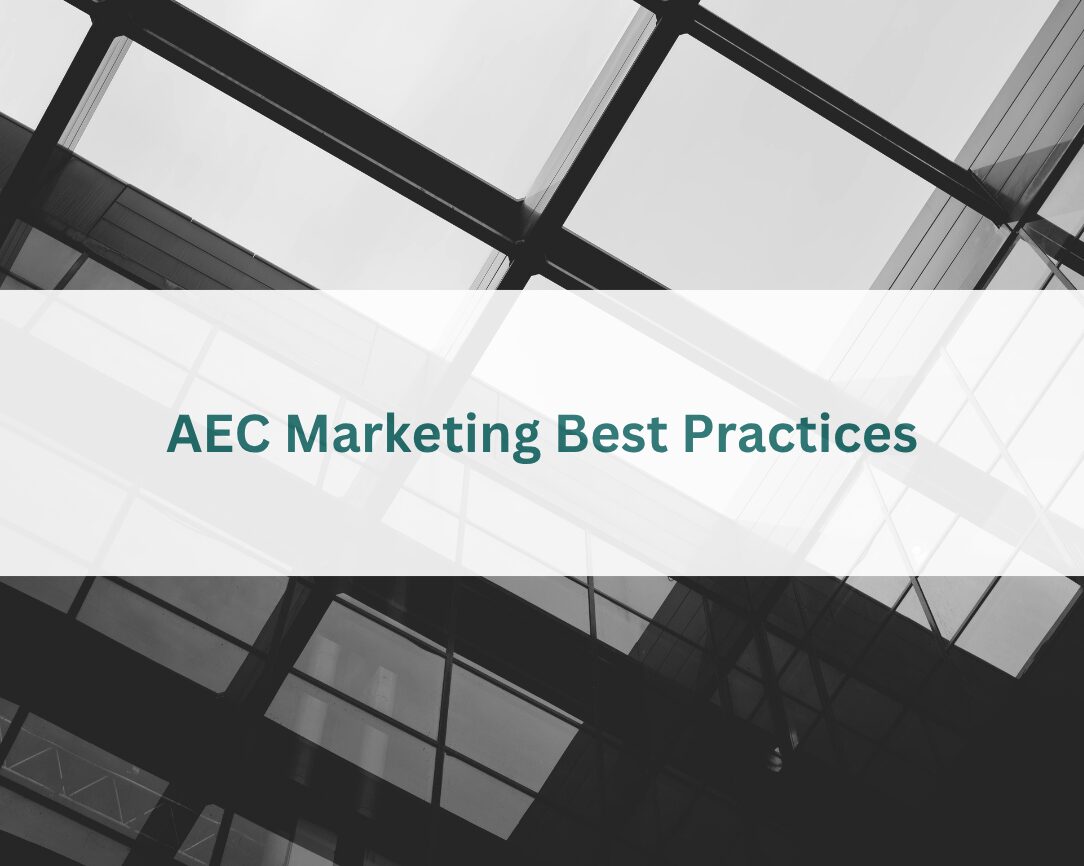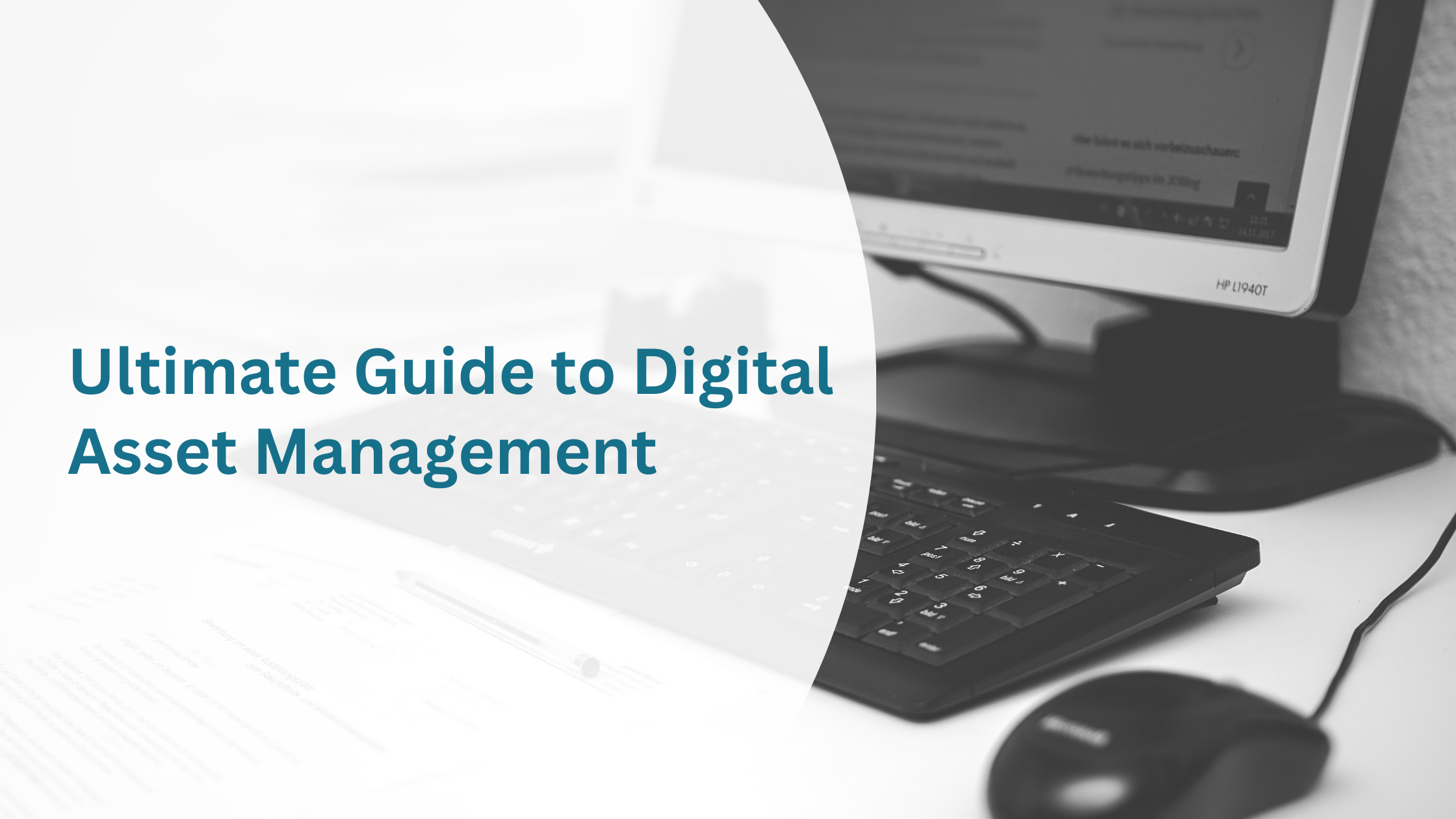AEC Marketing in 2025: How to Build a Plan That Drives Results
Jun 10, 2025

Updated: June 10th, 2025
The Architecture, Engineering, and Construction (AEC) industry has weathered massive change—COVID-19, supply chain disruptions, shifts in the workplace, and the Great Resignation. But now, it’s time to move from surviving to thriving. In 2025, the firms that succeed will be the ones that treat marketing as a strategic priority.
Too often, marketing is handed off to the newest admin or outsourced without clear direction. This approach might check boxes, but it won’t drive results. Whether managing marketing in-house or partnering with an agency, this guide is built to help you do better.
In this blog, you’ll find everything you need to build a modern AEC marketing plan—from setting the right goals and KPIs to choosing the right channels and prioritizing efforts that move the needle.
What Is AEC Marketing?
“AEC” stands for architecture, engineering, and construction. The term “AEC Marketing” refers to developing and implementing an AEC marketing strategy designed to achieve a specific marketing-related goal (or goals) in a focused and achievable way.
Why Is AEC Marketing Important?
AEC marketing is important because it enables you to grow your brand, outpace your competitors, and complete your digital transformation. However, according to OpenAsset’s The 2024 State of AEC Marketing report, 35% of firms spend less than 25% of their time on long-term marketing and brand strategy. Similarly, 40% of marketers dedicate under a quarter of their time to creating new content.
“What percentage of your team’s time is devoted to marketing strategy/brand-building?”

Most importantly, AEC marketing provides the tools you need to sever your reliance on traditional marketing activities, like radio, billboards, and magazine advertisements. Though traditional marketing efforts do serve a purpose, their potential as lead-generation tools is mediocre at best. That’s why any AEC firm looking to capitalize on lead generation in 2025 needs to prioritize its digital presence.
Looking to prioritize your digital presence? Start with OpenAsset, the only project-based digital asset management (DAM) platform designed for AEC companies like yours. Follow the link for a free demo.
The Fundamentals of AEC Marketing
So, how do you market your AEC firm in 2025? You start by identifying your goals and your target market. Ask yourself what you want to achieve and which customers you would like to work with. That’s where buyer personas come in.
Know Your Ideal Customer
Every marketing strategy starts with the development of buyer personas, a fictional representation of your ideal client(s) or target audience. The more accurate your buyer personas, the easier it will be to develop effective, targeted content that speaks to this buyer’s goals and challenges.
As such, the information you use to build your buyer personas should be based upon real data whenever possible. Lacking real data, your team will be forced to make assumptions about your audience, which can cause your marketing strategy to move in the wrong direction.
How to Build a Detailed Buyer Persona
To get the most rounded picture of your buyer persona, your research pool must include a mixture of customers, prospects, and people outside your contacts database who align with your target audience. Here are some starting points to get you started. Don’t forget to tailor these metrics to your particular business.
- Location
- Age
- Income
- Professional (Job) Title
- Goals
- Challenges
- Pain Points
- Interests
- Priorities
- Technology/Social Media
- Real Quotes
- Identifiers
- Common Objections
- What Can We Do?
Expect your personas to evolve over time as you explore new markets or service areas, so they need to be easily accessible, organized, and updated.
Specifically designed for AEC companies like yours, OpenAsset is the only project-based digital asset management (DAM) platform that is purpose-built to win you more business.
Understanding the Buyer’s Journey and the AEC Sales Cycle
Marketing success starts with meeting your audience where they are in their decision-making process. In the Architecture, Engineering, and Construction (AEC) industry, buying cycles are long, complex, and involve multiple stakeholders. To market effectively, you need to align your messaging with each stage of the buyer’s journey:
- Awareness: Your audience knows they have a problem or need—help them understand the challenge and why it matters. Content like blogs, social media posts, and industry trend reports are useful here.
- Consideration: Now they’re evaluating potential solutions. Case studies, project spotlights, and service guides show how your firm can help.
- Decision: They’re narrowing down vendors. Proposals, team bios, and client testimonials help build trust and move the deal forward.
When your content aligns with each phase, you’ll guide leads through the sales funnel more effectively—and win more qualified work.
Marketing Analytics: What to Track and Why It Matters
Without data, your marketing efforts are just guesses. That’s why marketing analytics is essential for AEC firms that want to grow strategically.
Go beyond vanity metrics like pageviews or likes and focus on KPIs that tie directly to your goals. Examples include:
- Website conversions from contact forms or downloads
- Email open and click-through rates
- Proposal win rates
- Engagement by persona or sector
- ROI by campaign or content type
Tracking performance helps you make smarter decisions, double down on what works, and cut what doesn’t. It also gives you the proof you need to advocate for more budget and resources.
Sales and Marketing Alignment
For your marketing plan to succeed, your sales and marketing teams must work together—not in silos. When these teams are aligned, marketing generates higher-quality leads, and sales is equipped with the tools they need to close deals faster.
Here’s how to encourage alignment:
- Hold regular check-ins between marketing and business development
- Share insights from both sides—what prospects are asking vs. what content exists
- Collaborate on proposal templates, case studies, and project narratives
- Use shared tools and processes for consistent messaging
OpenAsset supports this alignment by serving as a central source of truth for all visual and written assets, so both teams are always using the latest, most effective content.
Marketing Collateral That Supports Sales
Your marketing collateral should do more than look good—it should support your sales process. This includes:
- Branded proposal templates
- Project sheets and team bios
- Sector-specific brochures
- Case studies and one-pagers
- Award submissions and presentations
The challenge? Keeping everything up to date, consistent, and easy to access. That’s where OpenAsset makes a big difference. It helps AEC teams organize visual and written collateral by project, sector, or client, so the right file is always at your fingertips. No more version control issues or last-minute scrambles.
Building a Strong, Consistent Brand
AEC marketing isn’t just about promoting your latest project—it’s about building a brand that clients recognize and trust. A strong brand:
- Sets you apart from competitors
- Reflects your firm’s values and expertise
- Builds credibility with prospective clients and partners
- Attracts top talent
But maintaining brand consistency across channels, offices, and teams can be tough. That’s why leading AEC firms use tools like OpenAsset. With a centralized DAM system, your marketing team can manage logos, headshots, templates, and images in one place—ensuring every asset reflects your brand standards, every time.
Top AEC Marketing Strategies: Digital and Offline Tactics to Win More Bids
The idea behind content marketing is simple: publish written and visual material online with the purpose of attracting more leads to your business. Material includes:
Content Marketing
Online content marketing refers to any material you publish to your website, such as landing pages, testimonials, and pillar pages. A strong online content marketing strategy can help your firm rank higher in the search engine results pages (SERPs) and get your services in front of the right people at the right time.
OpenAsset’s home page is a great example. Note how the landing page immediately engages visitors with specific content about our products.
Blog Posts
Blog posts are a powerful form of inbound marketing that enables your firm to build the expertise, authority, and trust (EAT) you need to rank in the Search Engine Results Pages (SERPs) and build rapport with your audience.
Ebooks, White Papers, and Reports
Ebooks, white papers, and industry reports are high-value marketing assets designed to educate your audience and position your firm as a trusted expert. These downloadable resources go beyond surface-level content, offering in-depth insights, data, or guidance on a specific topic.
While ebooks are typically more visual and accessible—great for introducing complex ideas in an engaging format—white papers tend to be more technical or research-focused, ideal for prospects further along in the decision-making process. Reports, on the other hand, are often data-driven and tied to trends, benchmarks, or proprietary findings.
All three formats help:
- Generate qualified leads via gated content
- Support the buyer’s journey with valuable information
- Build credibility with clients, partners, and industry peers
- Provide long-form content you can repurpose across blogs, social media, and email
Video Marketing
88% of users say that they’ve been convinced to purchase a product or service by watching a brand’s video. When compared to the 11% of users who’d rather read a text-based article, it’s clear to see why AEC marketers are flocking to video marketing to boost conversions, improve ROI, and help you build relationships with your audience.
Account-Based Marketing (ABM)
Account-Based Marketing (ABM) is a highly targeted strategy that aligns sales and marketing to pursue high-value clients with personalized campaigns. Instead of casting a wide net, ABM allows AEC firms to zero in on specific accounts—like public agencies, developers, or institutions—and craft content that speaks directly to their needs and goals.
ABM works especially well in the Architecture, Engineering, and Construction (AEC) industry, where project timelines are long and buying decisions are complex. By focusing your efforts on a smaller number of high-potential accounts, you can:
- Build stronger relationships with key decision-makers
- Deliver more relevant content and proposals
- Increase your chances of being shortlisted
- Improve ROI by focusing on fewer, higher-value opportunities
Event Marketing
In-person and virtual events remain one of the most effective ways for AEC firms to connect with clients, partners, and prospects. Whether you’re attending an industry trade show, hosting a lunch-and-learn, or sponsoring a panel discussion, event marketing creates real opportunities to build trust, showcase expertise, and generate leads.
A well-planned event strategy can help you:
- Position your firm as a thought leader in your niche
- Highlight recent projects and capabilities
- Create face-to-face opportunities with key decision-makers
- Support ABM efforts through exclusive, invite-only experiences
- Collect valuable content (photos, testimonials, presentations) to repurpose later
Search Engine Optimization (SEO)
Search Engine Optimization (SEO) is how AEC firms expand their visibility in organic search results; drive more visitors to their website and increase their chances for more conversions, more customers, and more revenue.
In other words, SEO is a strategy to ensure that when someone Googles your service category, they find your website. It works by optimizing a website’s content, conducting keyword research, and earning inbound links to increase that content’s ranking and the website’s visibility.
We can’t hope to sum up the complex subject of SEO in a single blog post, but these resources should give you the information you need to get started with your SEO strategy.
- Search Engine Optimization: A Beginner’s guide from Ahrefs
- The Ultimate SEO Content Creation Guide
- The Ultimate Guide to SEO
- The Beginner’s Guide to SEO: Rankings and Traffic Through Search Engine Optimization
AEC Marketing Fact: 75% of marketers feel their SEO tactics are ‘extremely effective’ or ‘very effective’ at helping them achieve their marketing goals
Email Marketing
Email marketing is the process that AEC firms use to boost conversions, increase revenue and provide subscribers with valuable information that helps them achieve their goals. As an AEC firm, there are multiple ways to utilize email marketing to your advantage — the most common include using the tactic to:
- Build Connections: Build relationships and expand your network through personalized engagement.
- Increase Brand Awareness: Ensure that your firm and services are top-of-mind for the moment when your prospects are ready to engage.
- Promote Content: Send emails to share relevant blog content or useful assets (white papers, Ebooks, etc.) with your prospects.
- Generate New Leads: Entice subscribers to provide their personal information in exchange for an asset that they’d find valuable.
- Market Your Services: Promote your products and services.
- Nurture Leads: Delight your customers with content that can help them succeed in their goals.
This guide on How to Build an Effective Email Strategy has everything you need to create and send emails that your prospects actually want to read. As your email marketing strategy takes off, you may need a content management tool to supplement your email creation process.
This guide explores the five most common issues related to AEC firms and the technology they use to conduct email marketing, write proposals, collaborate on projects, and improve their project win rate.
AEC marketing Fact: 79% of marketers list email marketing in their top 3 most effective marketing channels.
Social Media
With 5.85 billion users projected by 2027, social media is an opportunity AEC firms can’t afford to overlook. A strong social media strategy helps you promote your services, build community, find new leads, and drive traffic to your business—but only if data backs it.
Too often, firms chase metrics like impressions, likes, shares, or views. While those numbers may look good, they don’t always reflect real progress. Instead, focus on data tied directly to your goals—think reach, engagement, click-through rates, sentiment, and hashtag performance.
High-performing social media content doesn’t just happen. It requires consistent, high-quality, purpose-driven content—whether it’s a 500-word blog post, newsletter, or project highlight. The goal? To educate leads, build trust, drive conversions, and show how your firm solves real-world challenges.
How to Build a Successful AEC Marketing Plan
Here’s how you can build a successful AEC marketing plan:
Identify Your Goals
Start by identifying your goals — be specific to your business — as they are likely to complement your broader marketing and company goals. Here are some goals to get you started:
- Improve brand awareness
- Boost revenue
- Increase conversions
- Improve brand loyalty
- Increase customer engagement
- Build rapport and trust among prospects and customers
- Attract strategic partners.
Determine Your KPIs
Once your goals are set, establish key performance indicators (KPIs) to measure progress. KPIs should be meaningful—not just easy-to-track metrics. For example:
- Brand Visibility: Website traffic, search rankings, media mentions
- Lead Generation: Number of qualified leads, conversion rates, form submissions
- Client Loyalty: Repeat project wins, referral volume, satisfaction surveys
- Engagement: Social media interactions, email click-through rates, webinar signups
- Partnership Development: New partnerships, backlink quality, co-branded campaigns
Plan Your Marketing Budget
A solid marketing plan needs a realistic budget to back it up. Whether you’re a small firm testing the waters or a large firm with national visibility, budgeting helps you prioritize efforts, allocate resources effectively, and avoid overspending on low-impact tactics.
Start by identifying your fixed costs—such as software, consultants, or advertising spend—and then allocate budget toward your key strategic goals. For example:
- Content creation and design
- Digital ad campaigns (Google Ads, LinkedIn Sponsored Posts)
- Event sponsorships or industry conferences
- Marketing technology (CRM, email platforms, DAM tools like OpenAsset)
- Photography, videography, or branding updates
Use the time-in vs. impact-out framework to weigh which initiatives deserve more investment. A highly visual project gallery that drives web traffic may be more valuable than a printed brochure that’s rarely used.
Choose Your Channels
Not every platform is worth your time. Use your ideal client profiles to guide where you show up. In the Architecture, Engineering, and Construction (AEC) industry, top-performing channels include:
- LinkedIn: Best for thought leadership, networking, and project promotion
- Email: A powerful owned channel for nurturing leads and clients
- Industry Events & Associations: Critical for relationship-building and visibility
- Facebook or Instagram: Ideal for showcasing culture, community, and visual work
Focus on where your audience already spends time, not where you feel pressured to be active.
Create and Distribute Content
Creating content is only one part of a successful marketing plan. The real challenge? Prioritizing what’s worth doing. Not every request will drive results.
Think in terms of time in vs. impact out:
- Quick wins: Repurpose existing content for social media, publish project photos, or share awards. These require less time and still drive visibility.
- Low-impact asks: Custom brochures for one-off requests or overly polished content that never gets shared may not move the needle.
Use an editorial calendar to manage your bandwidth, stay consistent, and track what’s performing. Focus your efforts on content and campaigns that align with your strategic goals—not just the loudest internal requests.
AEC Marketing Fact: 60% of marketers create one piece of content each day.
Track and Measure Success
To know if your marketing plan is working, you need to measure what matters. Tracking results helps you understand what’s driving real business outcomes—and what’s just making noise.
Start by reviewing the KPIs you defined earlier. Then set up dashboards or regular reporting to monitor:
- Website performance (traffic, conversions, bounce rates)
- Campaign metrics (open rates, CTR, form fills, lead quality)
- Sales pipeline impact (lead source attribution, proposal win rates)
- Engagement metrics (social shares, comments, downloads)
- Brand visibility (mentions, backlinks, keyword rankings)
Make it a habit to review these metrics monthly or quarterly. Look for trends, not just one-off wins. Over time, this will help you spot gaps, justify budget decisions, and make your case for more resources or a shift in strategy.
Test, Learn, and Refine
AEC marketing isn’t set-it-and-forget-it. The most effective plans are built with agility in mind. That means experimenting, evaluating, and evolving over time.
You don’t have to overhaul your strategy every quarter—but you should test new ideas regularly. Try A/B testing subject lines, experimenting with ad creative, piloting new content formats, or adjusting your targeting on digital campaigns. Keep track of what performs best and double down on those tactics.
Even small changes—like adjusting the timing of an email or updating the layout of a proposal template—can lead to meaningful improvements. The key is to stay curious, keep iterating, and treat your plan like a living document that improves with every insight.
Examples of AEC Marketing
AEC marketing isn’t just about publishing content—it’s about improving operations, saving time, and delivering proposals that win work. Here’s a real-world example of how a leading construction firm used technology to streamline their marketing and proposal processes.
Taylor Australia: Cutting Proposal Time in Half with OpenAsset
Taylor Australia, a prominent construction firm, faced a major efficiency challenge: creating resumes for RFPs took up to 12–20 hours per proposal, sometimes spanning two to three full days. For Submissions Manager Elizabeth Mackison, this process was not only time-consuming but critical—resumes were one of the most important components in winning work.
After implementing OpenAsset’s Digital Asset Management (DAM) solution, Taylor saw a transformation. With a centralized employee and project repository, plus advanced search and tagging capabilities, the team cut resume prep time in half. OpenAsset’s employee module streamlined everything—from finding headshots and project history to generating branded resume templates.
“[OpenAsset is] changing our lives.”
— Elizabeth Mackison, Submissions Manager, Taylor Australia
Additional benefits included:
- Fewer requests to team members for project info
- Consistency in resume layout and branding
- Faster team assembly based on project experience
- Long-term cost savings by avoiding the need to hire additional staff
For Taylor, improving marketing efficiency wasn’t just about speed—it was about building scalable systems that support growth, accuracy, and better collaboration.
Robins & Morton: Reducing Bottlenecks with Structured Asset Management
At Robins & Morton, the growing marketing and communications team needed a scalable way to manage visual assets and data across departments. Asset Coordinator Adria Klein led the effort to implement OpenAsset as their centralized image library, with a strong focus on process, permissions, and training.
They built a multi-departmental approval workflow, onboarded admins across offices, and even host an annual administrative summit to reinforce best practices. This structure empowered contributors to upload high-quality content while maintaining consistent standards.
“The confidence we now have is worth every bit of the transition… It saves so much time and so much frustration.”
— Adria Klein, Asset Coordinator, Robins & Morton
Today, Robins & Morton enjoys more accurate reporting, faster access to in-progress imagery, and full confidence that teams are using the latest, approved files—without unnecessary back-and-forth.
AEC Marketing Tips
Even with the right tools and strategy, success in AEC marketing comes down to execution. Here are practical tips to help you build trust, move faster, and make smarter decisions across your marketing workflows.
Use Testimonials, Reviews, and the Voice of the Customer
Client testimonials and reviews add credibility to your work. Instead of talking about how great your firm is, let satisfied clients do it for you. A strong quote on a proposal or a video clip on your homepage builds trust fast—especially for prospects unfamiliar with your brand.
Gather quotes after major milestones, project completions, or successful partnerships. The more specific, the better.
Showcase Your Team with Photos and Videos
People connect with people. Using professional team photos, behind-the-scenes videos, or even short clips from field staff humanizes your brand and builds authenticity. Prospects want to know who they’ll be working with—don’t hide the faces behind the projects.
Even simple iPhone videos edited with tools like CapCut can bring your story to life.
Use a DAM to Work Smarter, Not Harder
A digital asset management system (DAM) centralizes your project photos, headshots, brand templates, and past proposal content—making it easier to create consistent, on-brand materials at scale.
With the right DAM, your team spends less time searching for assets and more time building winning proposals and marketing campaigns.
Build a Process for Competing Priorities
Marketing teams in AEC firms are often small but stretched across every department. In fact, 69% of AEC marketing teams have fewer than 10 members, even at larger firms, meaning small teams are still expected to handle a broad array of tasks.
Without a process for intake, prioritization, and planning, you’ll constantly be stuck in reactive mode.
Create a lightweight request system, tie deliverables to business goals, and don’t be afraid to say “not now” when something won’t move the needle.
Manage Stakeholders with Clear Expectations
From principals to PMs to HR, everyone wants something from marketing. Set clear expectations early—around timelines, required input, and approval processes.
Regular check-ins, intake forms, and published timelines help you avoid bottlenecks and prevent last-minute fire drills.
Use AI Where It Helps—but Never at the Cost of Quality
Here’s the rule: if AI can make something repeatable, faster, or better, use it. But don’t sacrifice clarity or craft. In a sea of AI-generated fluff, high-quality content still wins.
Use tools like ChatGPT or Jasper to generate first drafts, analyze data, or brainstorm angles—but always add your expertise, brand voice, and final polish.
Treat Marketing Like a Science
Good marketing isn’t just creative—it’s strategic. Learn the fundamentals of conversion copywriting, UX principles, and buyer psychology. A clear call to action, intuitive page flow, and helpful messaging often beat flashy visuals or buzzwords.
Think like your user. What do they want to know, feel, or do next?
Always Fact-Check AI-Generated Content
AI is fast—but it’s not always right. Whether it’s a stat, client name, or project reference, verify everything. Misinformation—even small inaccuracies—can damage credibility and create risk.
Use AI to assist, not replace, your research process.
Optimize for AI, Not Just SEO
Search isn’t just Google anymore. With AI overviews, featured snippets, and voice search changing the way people find information, marketers need to write for how people consume content—not just what keywords they type.
Use clear headings, concise answers, and structured data that AI can easily summarize and surface.
Keep Testing
The digital marketing landscape is changing rapidly. According to Marketing AI Institute, 64% of marketers say AI is evolving faster than their organization can keep up. Staying agile is no longer optional.
A tool that worked last year might not be your best option today. Make space in your workflow to test new platforms, features, and automations.
Best Digital Marketing Tools for AEC Firms
Though digital marketing tools can only help you execute your marketing strategy, the right marketing technology (MarTech) stack can empower your firm to win more business and blow past the competition.
Reporting Dashboard
A marketing dashboard is a reporting tool that displays marketing metrics, KPIs, and analytics using data visualizations. The goal of a marketing performance dashboard is to answer the question: “How are we performing right now?” The most popular reporting dashboards for AEC firms include:
Customer Relationship Management (CRM)
Customer relationship management (CRM) platforms help AEC firms manage their pipelines, capture a complete view of their leads, and automate personalized marketing campaigns. The most popular CRMs for AEC firms include:
Marketing Automation
Marketing automation software platforms are designed for marketing departments and organizations to more effectively market on multiple channels online and automate repetitive tasks. The most popular marketing automation software platforms for AEC firms include:
AI Writing Tools
AI writing tools are built to help marketing teams brainstorm, draft, and refine content faster. From RFP narratives to blog posts and social captions, these platforms can speed up your workflow and reduce time spent on repetitive tasks. Popular AI writing tools for AEC firms include:
Lead Generation
In AEC marketing, lead generation is the initiation of consumer interest or inquiry into products or services of a business. A lead refers to the contact information and demographic information of a prospective customer who is interested in a specific product or service. The most popular lead generation software platforms for AEC firms include:
Project Management
Marketing project management represents the process of planning, overseeing, and delivering marketing-related projects. The most popular project management software platforms for AEC firms include:
Data Reporting and Analytics
Marketing reporting is the process of gathering and analyzing marketing metrics to inform future marketing decisions, strategies, and performance. Marketing reporting tools can uncover meaningful, actionable data that help you draw important conclusions and meet your firm’s business objectives. The most popular marketing reporting tools for AEC firms include:
Social Media Tools
Every stage of your social media marketing, from content curation to graphic design to analytics, needs some sort of software. Some tools cover multiple areas while others focus on and excel in only one. The most popular social media tools for AEC firms include:
Digital Asset Management
Digital asset management (DAM) is the process by which organizations store, share, organize, find, and retrieve digital assets from their ever-growing library of content, rich media, and digital materials, things like images, videos, audio files, branding material, presentations, proposals, and more.
In other words, digital asset management is how organizations keep and utilize digital assets they need to grow their brand, empower their sales teams, and disseminate a clear and purposeful message to their audience. As for the best DAM for AEC firms? There is only one DAM that is purpose-built for AEC firms like yours.
Video Tools
Creating marketing videos used to require big budgets and in-house production. Today, AI-powered video tools make it easier for AEC marketers to repurpose content, edit quickly, and publish high-quality videos that support proposals, project updates, and brand storytelling. The most popular video tools for AEC firms include:
Latest AEC Digital Marketing Trends & AI’s Impact
Digital marketing in the AEC industry is undergoing a transformation—driven by changing buyer behavior, emerging technologies, and the rapid rise of AI. Firms that embrace these shifts are not only improving efficiency but also positioning themselves to win more business in competitive markets.
One of the most significant changes is the widespread adoption of AI. 88% of marketers are already using AI in some capacity, and 85.8% plan to increase their usage over the next few years. For AEC marketers, this means tapping into AI for tasks like writing first drafts, analyzing campaign data, or auto-tagging assets, saving time without sacrificing quality.
AI’s impact goes beyond productivity. A recent survey shows that 84% of marketers say AI helps them deliver high-quality content faster, and tools like ChatGPT, Jasper, and Writer are becoming staples in modern martech stacks.
On the industry side, high-growth AEC firms are investing up to 10% of revenue in marketing, nearly double the investment of their slower-growing peers. These firms are also adopting digital-first strategies, such as video marketing, interactive content, and AI-enhanced proposals, to stand out in saturated markets.
As AI tools continue to evolve, it’s essential to test new platforms, monitor performance, and optimize for how people (and AI engines) now discover and evaluate content. Search is no longer limited to Google—AI-generated overviews and voice search are reshaping how your firm gets found.
The takeaway? AEC marketing in 2025 is about quality, speed, and adaptability. Firms that balance human creativity with smart technology will be the ones leading the future of digital growth.
Start Your Free OpenAsset Demo
Tired of digging through shared drives and outdated folders to find the right project image or resume? OpenAsset is the only project-based digital asset management (DAM) system built specifically for AEC firms—designed to streamline your proposals, marketing materials, and team workflows.
With powerful search, branded templates, and seamless integrations with your existing tools, OpenAsset helps you:
- Centralize project photos, team bios, and case studies
- Create consistent, on-brand proposals in minutes
- Empower marketing and BD teams to work faster and smarter
- Eliminate version control issues and manual asset requests





